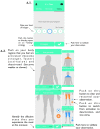Implementation Intention for Initiating Intuitive Eating and Active Embodiment in Obese Patients Using a Smartphone Application
- PMID: 29209236
- PMCID: PMC5702316
- DOI: 10.3389/fpsyt.2017.00243
Implementation Intention for Initiating Intuitive Eating and Active Embodiment in Obese Patients Using a Smartphone Application
Abstract
This article describes a study protocol, which aims to explore and describe the feasibility of a mobile-phone application for initiating intuitive eating and intuitive exercising in patients who are following an ambulatory treatment for obesity. Intuitive eating refers to one's ability to make food choices based on one's awareness of his/her body's response. Intuitive exercising encourages people in finding enjoyable ways of being physically active. These two components will be trained using an implementation intention procedure, that is, behavioral plans that aim at creating a strong link between a specified situation and a response. We aim to recruit up to 80 overweight and obese patients over a period of 2 years. The smartphone application will be assessed on the basis of (i) data obtained through a 4-week use period, (ii) self-report measures taken before and after the use of the mobile application, and (iii) feedbacks from participants after the use of the mobile application. This pilot study will allow us to better understand the applicability of the use of mobile application within ambulatory treatment settings, and to adapt the design of the app necessary for building cross-sectional studies investigating its efficacy.
Keywords: health at every size; implementation intention; intuitive eating; intuitive exercise; obesity; smartphone application.
Figures



References
-
- World Health Organization. Obesity and Overweight. (2017). Available from: http://www.who.int/mediacentre/factsheets/fs311/en/index.html
LinkOut - more resources
Full Text Sources
Other Literature Sources

